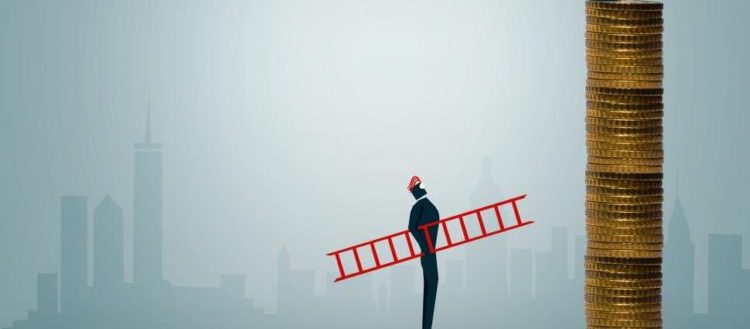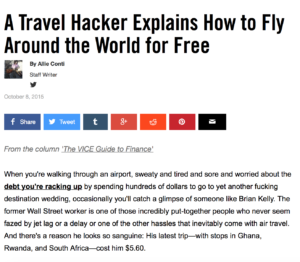
Collecting a Depreciating Asset
It’s great to have award points and miles to reduce or even eliminate the cost of travel, but points and miles inflation makes that increasingly difficult to keep up with the Joneses.
Most enthusiasts in this hobby refer to the various award points programs as “currency”, as each point earned has value. But like any currency, point and mile values fluctuate. Unfortunately most of that fluctuation is negative, in the form of devaluation and increasing award prices. And devaluation and increasing award prices = inflation.
As a few quick examples from my own portfolio, in mid-2015 I flew from North America to South Africa (via the One World airline alliance) in a mix of first and business class segments in planes equipped with flat bed seats for $112 in taxes and fees and 110,000 US Airways miles. Earlier that spring I traveled to from the US to Poland and back for $78 in taxes and 45,000 miles American Airlines miles. Those award prices are pretty amazing when you consider the combined cash price of those tickets is in the many thousands of dollars. Less than a year after I booked those tickets that same flight to South Africa priced out at 150,000 miles, and the flight to Poland jumped to 60,000 miles. That’s a 27% and 30% increase in miles for the same flights!
Points Enthusiasm on the Rise
According to a recent Wall Street Journal article, “About 60% of American consumers are enrolled in a credit-card rewards program that offers benefits such as cash back on purchases, air-travel miles, points that can be redeemed for merchandise and other enticements.” The proportion of people paying with credit cards vs. debit cards is also growing. Congress passed the Dodd-Frank bill in 2010 that lowered the debit card swipe fees that banks can charge merchants. Those debit card regulations dealt a large blow to a reliable source of income for banks issuing those cards. However the regulations did not affect the fees and restrictions linked to credit cards. As a result banks are shifting gears, pushing more credit cards to consumers and incentivizing them through rewards programs.
Airlines also profit tremendously from loyalty programs. In fact, some airlines are earning upwards of 50 percent of their yearly income from selling miles to credit card companies. The selling of miles are also relatively immune to economic cycles, providing banks with a nice revenue cushion in a downturn. According to recent Bloomberg article, Delta has revenues of over 300 million per year through its partnership with American Express and expects that figure to grow to roughly $4 billion by 2021. The cost for passengers redeeming those miles is seen as incidental in comparison to the money coming in from the sale of the miles. In other words, the airlines profit much more from selling miles than from the costs of people actually using them.
Even if travel hacking increasingly take advantage of award programs, the profit from the sale of miles and points is so large that companies don’t want to stop such an important component to their financial health and stability. As more points flood the market in various ways, the larger the supply becomes which ultimately devalues the currency.
Award Points and Miles Inflation
Points and miles inflation is depressing fact that people who engage in travel hacking often deal with. In the last several years, I’ve done a lot of reading about what award offers and redemption levels were like over the past 10 years or so. After comparing past award prices with the steadily increasing levels that we’ve seen more recently, I’ve come to believe that not only is inflation is happening, it’s happening at a faster and more dramatic pace than ever. These Wall Street Journal and Bloomberg articles illustrate similar points. As basic supply and demand models show, as scarcity rises (fewer airline ward seats for example), prices rise too. As travel hacking grows, we will continue to see these increases more more frequently, and perhaps more severely, than in the past.
As collecting points and miles has grown in popularity over the past 20 years or so, the amount of award redemptions have increased. This means that hotels and airlines are now giving out more products for free or nearly free. But free doesn’t pay the bills, and free doesn’t please the shareholders of massive publicly traded corporations either.
Airlines and hotels are now very well aware that there is a growing contingent of people looking to circumvent their profit model. And as airlines and financial firms have grown to utilize data and analytics more effectively, their ability to track and analyze travel hacking has grown too.
Points Saturation?
Although it may feel like some sort of secret society at times, the points game is not. People who collect, use and promote miles and points awards is becoming more and more mainstream. Alaska Airlines recently devalued its award chart and issued a statement specifically referencing “travel hackers” as a reason for the increased pricing. As a more local example, I was at a co-op grocery store a few weeks ago and while waiting in line, overheard a girl behind me talking with her friend about how her boyfriend was into ‘travel hacking’. If they would have been chatting about an upcoming sale at the mall or the Green Bay Packer football game fine, but travel hacking?
There are now thousands of internet and major media articles and videos, along with national seminars and even television appearances from notable bloggers that preach points and miles to a ever growing community. What was once a hidden hobby is now very much out in the open, and becoming much more mainstream. When you see some of the most notable points bloggers being featured on CNN, MSNBC, and many other major media outlets boasting about “free flights” and “free travel”, well my friends, you’re basically just waving a large red cloth and taunting the bull. The bull in this case being major multi-billion dollar international financial companies, international airlines, hotels, and travel related enterprises. And remember that bull has horns.

One of many articles glamorizing and promoting travel hacking
Here’s an example of a boast posts; or how big bloggers have come to love the limelight at the expense of everyone else. CNN, podcasts and other media have also put out recent eye popping pieces like this too. I listened to a points podcast recently that openly mocked banks and airlines while touting a system that is directly linked with companies in both those industries.
I don’t like the attention drawing articles from bloggers or others bragging about ‘free flights’ and travel. Usually the reporting is inaccurate at best, and the publicity is largely self serving. They are enriching their blogs in the short term – more visitors, more clicks, more credit card applications, and more revenue generated. It’s also a form of narcism topped with insecurity and greed.
What do you think banks, airlines and hotel companies think when they see those pieces? Those pieces probably aren’t giving them new information, but I’m guessing they are pleased when they read them.
Then I think about how I heard about the hobby back in 2011. I listened to an NPR piece about the US Mint deal, then a year or so later heard a points blogger on my local radio station talking about points and miles. From there I was hooked. So without those two events, I would not have taken the path that I did – or at least not at the same time or in the same way. What if my blog grew and I was asked to do an interview for USA Today or similar publication? Would I turn it down because I didn’t want to bring attention to the hobby? Or would I try and promote my blog as responsibly as I could? In the end, I think my main beef with large scale promotional pieces is that they are inaccurate and flashy. The reporters and news sources understand only the bare bones of the hobby and only paint a glittery picture that sells copy.
Pumped Up
Companies within the travel and financial world can look at the past 10-15 years and see the trend. More stays, flights, hotels, and car rentals are not being paid for with actual money, but with points and miles and that is a flashing yellow caution sign. There is an immense amount of pressure on large, publicly traded corporations to produce growing profits, and giving away things for free or nearly free is a threat to their success. So to counter the trend, these companies increase the award redemption levels. They may be devaluing the points currency (airline miles, hotel points, general travel points, etc.), but also increasing the supposed value of the award program by putting a premium price tag award redemptions for customers.
I’m not particularly worried about travel hackers to be able to keep up with rising award prices. We find ways to max out purchases, follow new trends, and use methods to gain points en masse. But I feel sorry for the average person or family who is barely or not at all involved with points collecting, because they can’t possibly keep up with points inflation, much of which has been artificially created by those, including myself. The little guy or family who isn’t engaged in travel hacking is largely being left in the dust. When award prices keep rising, that ‘free’ flight or other benefit moves further and further away from becoming a reality.
A substantial percentage of award miles and points also go unclaimed and never get used. According to a June 2016 article in the Financial Times, American Airlines had approximately 854 billion unclaimed miles from its Advantage program and the German carrier Lufthansa had 211 billion unused. In 2013 the DailyMailUK stated that there were an estimated 14 trillion unused airline frequent flyer miles and that roughly half of the flyers don’t actually redeem the rewards they earn. Not redeeming points earned is also very favorable to the companies that issue them, and entice more miles to be sold in the future.
Summary
Points and miles inflation causes travel award levels to become more and more difficult to reach, as more and more points and miles are needed to redeem for nearly free travel. At the same time, the people tied into the points game can still achieve award redemptions, although possibly not as many or as easily as before, while the average person is faced with a much steeper ladder. Points and miles inflation is essentially creating a points and miles disparity, similar to the income disparity that’s a politically en vogue topic, between the rich (aka points game pros) and the poor (those without many points or who don’t know how to maximize their points portfolios).
Major points and miles bloggers are tied in with the credit card companies that they advocate hacking. The simple disclaimers found on those sites state there is a relationship, but often doesn’t provide many details about it. It’s a relationship that is murky and rarely discussed. I would like to see more information on the types and levels of compensation that bloggers receive from banks, airlines, and hotel companies.
My advice to compensate for rising award prices is to 1) earn as many points as you can to keep your balances up, 2) select your awards efficiently, 3) spend and redeem your points, don’t hoard them. Spending points is not easy or possible for everyone to do, I get that. I’m one of those people. Even though I try and travel overseas 3-4 times a year using points and miles, I’m earning them at a rate that surpasses how fast I can actually use them. The leftover points are growing and just sitting there in my accounts, like cash under a pillow, slowly losing value over time.
